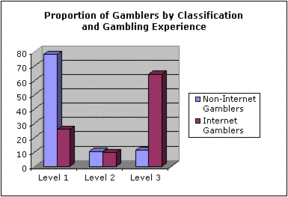The WAGER Vol. 7(15) – Netizens @ Risk: Online Gambling and Addiction
Researchers have suggested that technology influences psychological and social processes (Kipnis, 1991). The corollary is that addiction may be related to technological advance. The continuing rise in popularity of the Internet for communication, education, and entertainment provides an opportunity to explore the relationship between addiction and technology. The WAGER reports the results of a recent study of gambling problems among Internet and non-Internet gamblers (Ladd & Petry, 2002).
Individuals (n=389) from university dental and health clinics either agreed to fill out a questionnaire after being approached by experimenters or voluntarily filled out the same questionnaire that was left in clinic lobbies over a period of 13 months. The questionnaire consisted of the South Oaks Gambling Screen (Lesieur & Blume, 1987) and several questions about gambling habits and demographics.
Ladd and Petry reported that 100% of participants engaged some lifetime gambling, 90% gambled in the past year, 70% gambled in the past 2 months, and 42% gambled in the past week. Of the total number of participants, 8% (n=31) reported lifetime Internet gambling and 3.6% (n=14) reported weekly Internet gambling. The mean SOGS score of Internet gamblers (M=7.8, SD=2.0) was significantly higher than the mean SOGS scores of non-Internet gamblers (M=1.8, SD=3.4). The chart below presents the proportion of gamblers who researchers classified as level 1 (non-problem), level 2 (problem), and level 3 (pathological) gamblers.
In this study, individuals who gambled on the Internet were more likely to be probable pathological gamblers than individuals who did not gamble on the Internet. However, there were some limitations to this study. Although the authors recognized that self-selection could have played a big factor in the reported findings, they did not report the number of individuals recruited in person versus the number who filled out questionnaires on their own. It is possible that individuals who chose to fill out the questionnaires did so because they liked gambling; everyone who participated had a lifetime history of gambling. Consequently, the overall prevalence rate of problem gambling (level 2 and level 3) of 26% is higher than expected in the general population, which includes a number of people who never gambled. In addition, the study did not measure the temporal relationship between gambling problems and Internet gambling. Although it may be tempting to suggest that gambling on the Internet leads to gambling problems, the converse is also likely and this study does not provide evidence either way. Finally, the actual number of individuals in the study sample who reported Internet gambling was very small. Thus, the results should be confirmed with a larger, longitudinal study of randomly selected participants. Nevertheless, this research provides an interesting insight into Internet gambling and its relationship to problem and pathological gambling.
Comments on this article can be addressed to Debi LaPlante.
References
Kipnis, D. (1991). The technological perspective. Psychological Science, 2(2), 62-69.
Ladd, G. T., & Petry, N. M. (2002). Disordered gambling among university-based medical and dental patients: A focus on internet gambling. Psychology of Addictive Behaviors, 16(1), 76-79.
Lesieur, H. R., & Blume, S. B. (1987). The South Oaks Gambling Screen (SOGS): A new instrument for the identification of pathological gamblers. American Journal of Psychiatry, 144, 1184-1188.
